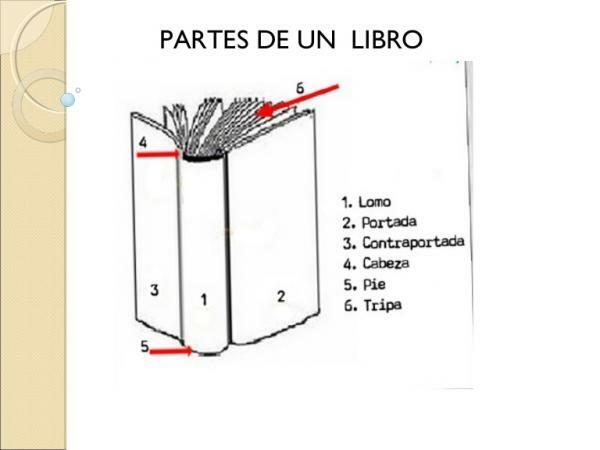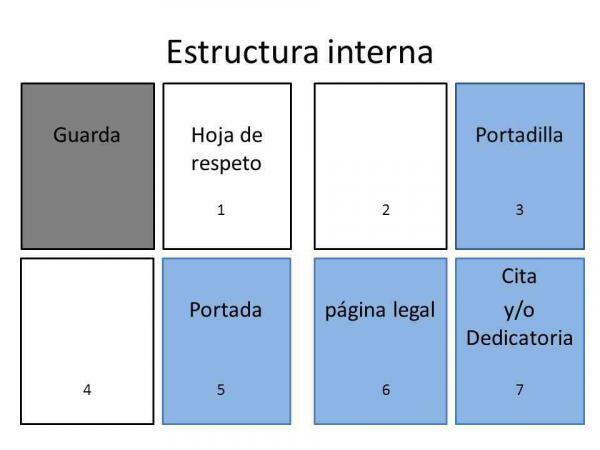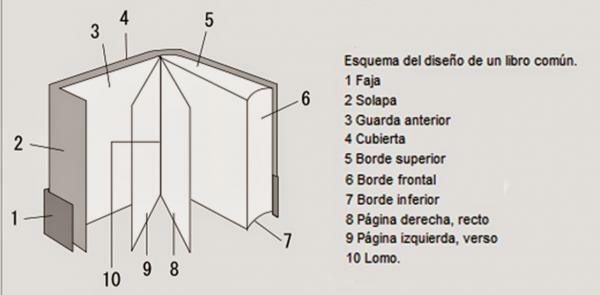Parts of a book: external and internal

Image: Slideshare
The process of creating a book requires not only the participation of the author with the inventiveness of the text itself, but it is It is necessary to pay attention to all those elements that make up the physical book and that are carried out during the process editorial. In this way, within the structure of a book two blocks are distinguished: the inside and outside of a book. In this lesson from a PROFESSOR we will help you unravel all these elements so that you know how to differentiate them. You dare?
Index
- Differences between the internal and external parts of a book
- Internal parts of a book
- External parts of a book
Differences between the internal and external parts of a book.
As we have highlighted, a book is composed in the first place by the text itself, that is, the information or story that you want to tell, and that constitutes the axis or central part around what revolves all the book. From there, it is mandatory to structure the other elements that compose it and make the first distinction between internal and external parts of the book:
- Internal parts of a book: it is made up of the texts by which it is composed, not only the body or main story but all those texts come into play that appear from the first or last pages such as the introduction, dedications, acknowledgments, prologue or epilogue etc.
- External parts of a book: they are the physical parts of a book, that is, the covers with the front and back covers or the spine, among others. All these elements are created thanks to the work of the publishing sector, which through a previous editing process and subsequent layout, give birth to the book in question with all its structure already formed.

Image: Alquiblaweb
Internal parts of a book.
We will see below and in detail the internal elements of a book. First we have to make the difference between the body of the work and the rest of the texts annexed to the main work that are in the first or last pages of the book. Thus we find information in what could be three sections of a book: the first pages, the body of the work and the last pages. We present them here below:
In the first pages from a book we find:
- dedications: to whom the author wishes
- epigraph: is a quote from another author that refers to the content of the book
- thanks: to whomever the author wants
- general index: summarize or outline the contents of the book
- preface or introduction: introductory text written by a person other than the author and who knows the topic developed in the body of the book
- Foreword: text written by the author or normally another person in which comments about the work are included and the end of the book is justified
The body of the work:
- The body can be divided into chapters and constitutes the essential part where the content is developed, that is, about what you want to talk about
On the last pages of the book are:
- appendices or annexes: they constitute complementary information to the content that helps to interpret technical aspects or clarify essential parts
- bibliographies: are the references to other books that the author used as a basis to develop his own theme
- colophon: brief note on details regarding the printing of the book
- epilogue: text in which a summary or conclusion of the developed topic is presented
- glossary: it constitutes an annex by which the explanation of terms found in the book are included and that serve as clarification to the reader in order to improve their understanding
Likewise, as internal parties we could highlight the information that appears in the cover page and the back cover by the fact of being relative data or belonging to the book but that nevertheless can also be classified as external elements since they are found on the covers of the book. In this way, the title of the work and the name of the author are added on the cover, while on the back cover there is a text-summary of the work with quotes or professional criticisms in such a way that they incite and encourage the reader to read the book.

Image: Partsof
External parts of a book.
Finally, regarding the external parts of the book we have highlighted that they are all those elements belonging to the layout, that is to say, what gives physical form to the book. Among these parts are:
- covers: are the outer parts of the book, made from a harder material. The front cover would be what we call the cover in which, apart from the title and author, an illustration can be added; and the back cover would be what we call the back cover.
- loin: is the part that holds all the sheets and that joins the two covers, sometimes the title of the book and the name of the author are included
- flap: is a list where other books in the collection are included
- editorial parliament: sheet that includes information on the credits of authorship, translation, edition number, year of publication, etc.

Image: Tresyeah
If you want to read more articles similar to Parts of a book: external and internal, we recommend that you enter our category of Literary concepts.



